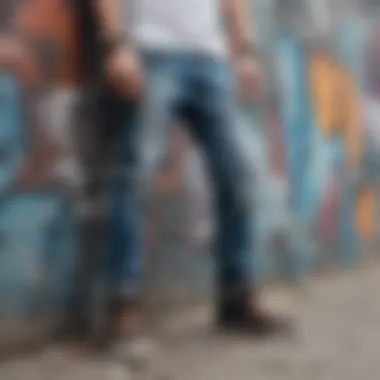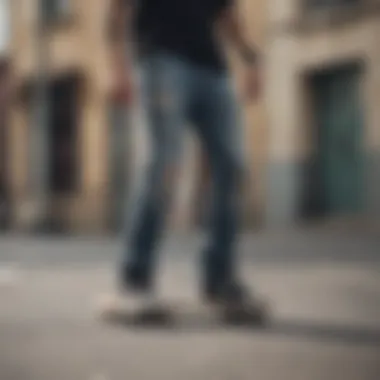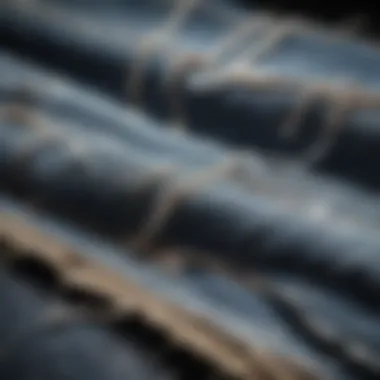Why Ripped Jeans Define Men's Skate Fashion


Intro
Ripped jeans have carved out a niche that goes far beyond their humble beginnings as a mere fashion statement. Their roots sink deep into the heart of skate culture, where they blend classic rebellion with a sense of unrefined practicality. While some see them as a simple fad or a way to display a certain attitude, for skaters, these jeans carry weight. They embody identity, freedom, and the ethos of a subculture that thrives on self-expression and creativity.
From the streets of California to skate parks around the globe, ripped jeans remain a staple in the wardrobes of skaters. Their enduring appeal can be traced back to several pivotal influences, which include their ease of movement and adaptability to the rugged lifestyle that skateboarding demands. In this article, we’ll unpack various elements that make these jeans not just a trend, but a symbol of a way of life.
Techniques and Skills
Understanding the techniques behind wearing and maintaining ripped jeans can enhance a skater's experience on and off the board. There's more than just picking any old pair off the rack.
Essential Tricks for Beginners
For newcomers to the skate culture, the first step is to identify the right style of ripped jeans. Not all styles are created equal, and what works for one skater might not for another. Here are some key pointers to consider:
- Fit: Opt for a relaxed or loose fit, allowing adequate room for movement. Skinny jeans might restrict your mobility.
- Rips: Look for jeans that have a balanced distribution of rips, ideally around the knees or thighs. This not only adds flair but also helps with ventilation during hot summer sessions.
- Durability: Choose jeans made from sturdy fabric. Skateboarding can be hard on clothes, and investing in quality materials will save money in the long run.
As you adapt to the skate scene, it’s also beneficial to learn how to maintain the jeans. Regularly check them for frays or tears as they can progress quickly from cool to tattered.
Advanced Techniques for Pros
For seasoned skaters, ripped jeans become a canvas for personal expression. Here are strategies that elevate style and functionality:
- Customization: Sew patches or add embroidery to stand out. Personal touches can set your style apart on the board.
- Layering: Experiment with layering textures. Pair edges of ripped jeans with combat boots or high-tops for a sturdy look while riding.
- Maintenance: To keep your jeans looking sharp without losing character, wash them in cold water and air dry. This approach also helps preserve the fit and rips.
Skateboarding Culture
Skateboarding is more than a sport; it’s a lifestyle imbued with history, evolution, and progressiveness. Ripped jeans are inherently tied to this narrative, symbolizing the grit and creativity that the culture champions.
The Evolution of Skateboarding
Originating in the late 1940s and gaining momentum by the 1970s, skateboarding reflects a rebellion against the norms. With its roots in surfing culture, it allowed individuals to carve out their unique paths. Ripped jeans entered the picture in the 1980s, aligning perfectly with the DIY ethos prevalent amongst skaters who embraced imperfections and unconventional styles.
Influential Skateboarders and Their Impact
Icons like Tony Hawk and Rodney Mullen have not just shaped the sport but also influenced street fashion, including ripped jeans. Their major public appearances frequently feature this clothing style, inadvertently leading the way for others to follow:
- Tony Hawk: His adventurous spirit and passion for skating inspired a generation, making his choice in attire influential.
- Rodney Mullen: Known for his technical tricks, Mullen's unique style made waves in the skating community.
"Skating is not just about the tricks; it's about being true to yourself and expressing that through your style, including what you wear."
In summary, ripped jeans transcend their simple aesthetic appeal. They are a testament to a lifestyle that embraces freedom and individuality. In the following sections, we’ll delve deeper into more aspects of ripped jeans within skate culture, from stylistic choices to maintenance tips, offering readers an intimate understanding of how they can make these jeans their own.
Prolusion to Ripped Jeans
The world of ripped jeans is more than just a fashion statement; it embodies an entire culture and attitude that resonates deeply within skateboarding scenes. Ripped jeans have carved out a distinct niche in men's fashion, particularly among skaters, where style and function must go hand-in-hand. In this section, we will explore what sets ripped jeans apart, their historical roots, and how they’ve become a staple in skate culture.
Defining Ripped Jeans
Ripped jeans typically refer to denim pants featuring intentional tears, frays, or cutouts, usually located around the knees, thighs, or pockets. This rugged, worn-in look is not merely an aesthetic choice but serves practical purposes as well. While some might find them untidy, for many skaters, the ripped detailing exemplifies a certain rebelliousness that echoes the spirit of skateboarding itself. They embody a relaxed fit which allows for ease of movement, important when you're hitting the half-pipe or mastering that next trick.
The appeal lies in their versatility. You can sport them at the skate park or pair them with a clean shirt for a casual night out. Additionally, the aesthetic can vary greatly depending on the degree of wear and the style of the jeans—some may prefer more significant rips while others may opt for subtle frays. This flexibility makes ripped jeans a canvas for self-expression, allowing wearers to showcase their personal taste.


A Historical Perspective
Ripped jeans have their roots in the counterculture movements of the late 20th century. Originally associated with punk rock and grunge, these jeans began to appear in the wardrobes of individuals who sought to defy societal norms. They became a symbol of rebellion, representing not only a rejection of mainstream fashion but an embrace of individuality.
In the early days of skate culture, skaters often wore secondhand or thrifted jeans. The wear and tear that naturally occurred during falls and scrapes transformed these garments into something uniquely theirs. Unlike the pristine jeans common among other fashion circles, ripped jeans became synonymous with authenticity and lived experiences, making them suitable for the grit and grind of urban skateboarding.
As skateboarding gained popularity, particularly in the 1980s and 90s, the style hit the mainstream. Designers started to adopt ripped jeans into their collections, elevating them to a more fashionable status. However, for many skaters, the allure remains in those earlier imperfections – the very marks indicating a life well-lived on the board.
Overall, understanding the definition and historical evolution of ripped jeans deepens our appreciation for why they hold such a lasting appeal in skate culture. They’re not just a piece of clothing; they tell a story of defiance, creativity, and a connection to a beloved subculture.
Cultural Significance of Ripped Jeans
Ripped jeans are more than just articles of clothing; they serve as a vivid symbol within the tapestry of skate culture and youth identity. Understanding this cultural significance sheds light on why these distressed denims have remained a staple for generations of skaters. The very act of wearing ripped jeans is often seen as a form of rebellion and authenticity, resonating with the core values of skateboarding. In this section, we will explore the deep-seated importance of ripped jeans in both skateboarding and broader youth culture.
Ripped Jeans in Skateboarding
When it comes to skateboarding, ripped jeans signal a certain level of commitment to the sport. Skaters often engage in activities that may wear down their clothing, inherently leading to those infamous rips and tears. Not only does this showcase the physicality of the sport, but it also fosters a sense of camaraderie among skaters, as they recognize the wear and tear that come from hours spent grinding or performing tricks.
The choice of ripped jeans goes beyond mere functionality; it also reflects a skater’s aesthetic. Many skateboarders intentionally buy jeans that are already distressed or embark on DIY projects to create their own unique rips. They use the jeans as a canvas for individual creativity, matching their personal style with the distinct culture of skateboarding. Moreover, the prevalence of brands like Levi's, Vans, or Dickies in the skate scene underscores how these choices have been embraced across various eras in skate history.
Influence on Youth Culture
Ripped jeans are not just confined to the skateparks; they have transcended into the broader spectrum of youth culture. They represent a mindset—one of freedom, rebellion, and individuality. Teenagers and young adults alike have adopted ripped jeans as a uniform of self-expression. Whether it’s gracing the halls of high school or hanging out at cafes, the ripped denim signifies a rejection of traditional norms and expectations.
This choice of attire takes on layers of meaning, sewn into the fabric of youth rebellion. Many identify with the do-it-yourself ethos that accompanies the customization of ripped jeans. It allows for a playful yet assertive statement against mainstream fashion trends. Students, artists, and musicians who've made their mark often sport these jeans as badges of honor.
"Ripped jeans connect our generation to the raw, unfiltered experiences we share, an aesthetic that is relatable and real, showcasing not only the style we choose but the stories we carry."
Essentially, ripped jeans function not only as a fashion statement but also as an emblem of community and belonging. They invite conversations, create bonds, and speak to shared values among the youth.
In summary, the cultural significance of ripped jeans in skateboarding and youth culture is multilayered. They encapsulate a lifestyle and identity that extends far beyond mere fashion, serving as a vivid canvas for personal expression and collective ethos.
Practical Benefits of Ripped Jeans for Skaters
Ripped jeans have carved a niche in the skate culture, going far beyond mere fashion. Their practical benefits are often overshadowed by their popularity, yet they play a crucial role for skaters looking for both functionality and style. When you jump on a skateboard, comfort and mobility become paramount. This section aims to delve into the two core benefits that make ripped jeans a top choice for skaters: mobility and comfort, as well as breathability during sessions.
Mobility and Comfort
Skateboarding is an activity that demands freedom of movement. Ripped jeans, with their strategically placed tears, offer skaters a kind of flexibility that traditional denim often lacks. Picture this: you're grinding on a rail or trying to catch some air off a ramp. A non-stretchable pair encourages stiffness, while ripped jeans provide that welcome freedom.
Moreover, many ripped jeans include a degree of stretch in their fabric, which enhances comfort significantly. The absence of that rigid "old-school" feel allows for a more natural range of motion. Ultimately, this contributes to a smoother skateboarding experience—one that lets you focus on perfecting those tricks instead of worrying about restricting your legs.
"Having the right pair of jeans makes a world of difference on the board; it’s all about feeling like you can move without a care in the world."
Breathability During Skate Sessions
If you've ever spent a hot summer day skating, you know that perspiration can be an unwelcome companion. Ripped jeans naturally provide ventilation, thanks to the open rips. Unlike solid denim, which can trap heat and moisture, the ripped sections allow air to flow freely, helping you keep cooler.
Additionally, skaters often prefer wearing lightweight denim, which enhances breathability and reduces discomfort. The fabric's weight, paired with the rips, creates an environment that encourages air circulation. When the sun is blazing down and you're pushing hard, being able to breathe in your jeans can set you apart from the crowd.
Styling Ripped Jeans for Men


Diving into ripped jeans, especially within the skate culture, extends far beyond just putting on a pair of distressed denim. These jeans have become a symbol, a language of their own in men's fashion. Their unique style offers a myriad of options that allow for individual expression without saying a single word. In skate culture, where authenticity meets creativity, styling ripped jeans is essential, showcasing not just a fashion choice but also a lifestyle.
Different Styles of Ripped Jeans
When it comes to styling, not all ripped jeans are created equal. The variations can significantly alter an outfit's vibe. You might go for skinny, slim-fit, or even loose-fit options, and they each serve a distinct purpose. Skinny ripped jeans create a sleek silhouette, perfect for a tighter look that emphasizes leg lines and pairs well with a fitted tee. Slim-fit offers a middle ground, allowing for movement while still giving off that polished skater edge. On the other hand, loose-fit ripped jeans offer comfort and a laid-back appearance. They are especially favorable during warm weather, ensuring breathability while skating.
Moreover, the placement and size of the rips can vary. Subtle scratches might be more appealing to some, while others might opt for larger, more aggressive cuts. The choice of wash is also key: distressed shades might evoke a vintage surf vibe, while darker washes may lean towards modern aesthetics. Combining these elements can result in a truly personal style statement.
Pairing with Skate Shoes
Choosing the right footwear is just as crucial as selecting the ideal jeans. Skate shoes often have unique characteristics that can enhance the overall look when paired with ripped jeans. Low-top sneakers tend to flow seamlessly with skinny jeans, accentuating the leg while providing ease of movement. It’s always wise to consider comfort because skateboarding requires agility. Brands like Vans and Nike SB offer models designed with both functionality and aesthetic in mind. These shoes often come in black or white to match any denim wash but adding a pop of color doesn’t hurt either.
Moreover, while dressing for the skate park, pairing your ripped jeans with chunky shoes can add an edgy contrast. Just avoid shoes that are overly bright or flashy, as they might detract from the jeans’ rugged appeal. Balance is key, allowing the jeans to take center stage without distractions.
Accessorizing Ripped Jeans
Accessorizing ripped jeans provides an additional avenue for personal expression. A well-chosen accessory can elevate a simple outfit to something memorable. Think about your belts, bracelets, and even hats. These items are not mere afterthoughts; they can solidify your style narrative. A canvas backpack or a crossbody bag can add functionality while contributing to the overall aesthetic.
In terms of belts, consider opting for thicker leather or a woven option that complements the ruggedness of ripped jeans. The right belt can break up the outfit and add a touch of texture.
Additionally, don’t underestimate the power of jewelry. A few subtle rings or a well-placed chain can enhance the overall look, adding flavor without overwhelming the outfit. Ultimately, accessories should not compete with the ripped jeans but rather complement them, enriching the narrative of who you are as a skater.
"Fashion is about expressing who you are, and ripped jeans offer that raw canvas where creativity can flourish."
In summary, styling ripped jeans isn’t just about throwing them on; it's about curating a look that aligns with your identity within the skate culture. Every aspect counts – from choosing the right fit and pairing it with complementary footwear to accessorizing in a way that tells your story. By focusing on these elements, you elevate your ripped jeans from casual wear to a true representation of your personal style.
Maintenance and Care of Ripped Jeans
When it comes to maintaining ripped jeans, a blend of care and consideration makes all the difference. Ripped jeans, especially in the skate culture scene, are often seen as a badge of honor—each rip representing a story and a lived experience. However, over time, neglect can turn what’s once a fashionable piece into a worn-out relic. Therefore, knowing how to properly maintain and care for these jeans is crucial for preserving both their aesthetic and their function.
Keeping ripped jeans in good shape not only boosts their longevity but also enhances the wearer's overall style. A well-maintained pair of ripped jeans can serve as a versatile staple, allowing skaters to transition easily from the skatepark to casual outings with friends. Plus, investing a bit of time into their upkeep can prevent more significant repairs down the line, saving both time and money in the long run.
Washing Techniques
Washing ripped jeans is somewhat of an art and there are a few techniques that can ensure they look good for years. Here are some essential tips to consider:
- Cold Water: Always opt for cold water when washing ripped jeans. It helps preserve the color and prevents the fabric from shrinking.
- Inside Out: Turning the jeans inside out before washing minimizes wear on the outer fabric and protects the rips.
- Gentle Cycle: Choose a gentle cycle for your wash. Rough cycles could further deteriorate the fabric and cause unwanted fraying.
- Avoid Fabric Softener: While it might sound counterintuitive, fabric softener can break down the fibers, potentially causing more rips or even fading the color.
- Air Drying: For the best results, avoid the dryer. Air-drying helps retain the shape and keeps the jeans from getting overly worn out. A simple clothesline or a flat surface will do.
By following these washing techniques, you can ensure that your ripped jeans maintain their style and structural integrity while keeping those rips looking sharp.
Repairing Rips
Rips are what make these jeans special, but some tears can go too far. Learning the right way to repair them is essential for skaters who want to keep their favorite pairs intact. Here are some methods:
- Iron-on Patches: If you’re dealing with a tear that’s growing, iron-on patches are a solid fix. They can add a pop of color or texture, giving personality to an already unique piece.
- Stitching: For smaller rips, a simple needle and thread can be your best friend. Stitching them back together keeps the look authentic while ensuring they won’t become bigger rips.
- Fraying Strategy: Sometimes, intentional fraying can bring a certain style. Using sandpaper or a cheese grater on specific areas can enhance the distressed look.
- Sewing Machines: If you’re handy with a machine, sewing can create a pattern or design across the tear which not only repairs but also adds to the aesthetic.
"Your jeans tell a story, and keeping them in shape means writing more chapters."
Repairing your ripped jeans isn’t just about fixing something that’s broken; it’s about celebrating your style and the life you’ve lived in them. Understanding how to take care of these jeans ensures that they remain both functional and fashionable within the skate culture narrative.
Ripped Jeans as a Canvas for Personal Expression


Ripped jeans represent more than just fashion; they serve as a significant medium for personal expression within the men's skate culture. Each tear, every fray, becomes part of a story that reflects the identity and individuality of the skater. Ripped jeans allow wearers to break away from mainstream fashion norms, embracing the rough edges and imperfections that come with both the garment and their lifestyle. This section delves into the various ways ripped jeans act as a canvas for creativity and self-representation.
Customization and DIY Touches
Customization adds another layer of meaning to ripped jeans. For skaters, it’s not uncommon to see jeans adorned with patches, paint, or even embroidery. This DIY approach allows them to mark their territory and showcase personal style. Popular trends include:
- Paint Splatter: A nod to the artistic aspect of skating, bright splashes of color can transform a pair of jeans into a unique piece of art.
- Patches: From band logos to personal insignias, patches can add a layer of nostalgia or affiliation, offering a connection with music or movements.
- Frayed Hems and Cutouts: Taking it a step further, many skaters choose to modify not only the rips but the overall cut and hem of their jeans, creating a custom fit that matches their skateboard style.
DIY customization not only makes each pair of jeans one-of-a-kind but also facilitates a bond with the garment, often associated with countless skate sessions. It encourages originality, as each modification tells a different tale – one shaped by experiences on and off the board.
Statements of Identity
Ripped jeans are powerful statements of identity in skate culture. They invite wearers to display their distinctiveness and stand out in a sea of conformity. These jeans form a bridge between personal storytelling and community belonging. In many ways, the rips symbolize the journey skaters embark upon, confronting challenges and enjoying the thrill of the ride.
- Symbol of Rebellion: Wearing ripped jeans often signifies a rejection of conventional fashion standards, embracing a lifestyle that is raw and unrefined. This rebellion is crucial in defining skate culture, where nonchalance becomes a badge of honor.
- Camaraderie: By showcasing their unique styles, skaters create connections with others who share similar values. Ripped jeans often become a part of group identity, fostering mutual respect among peers.
- Cultural Commentary: Many use their ripped jeans to make a potent statement about societal norms. Whether by incorporating bold graphics or messages, these jeans can spark conversations about various issues, from sustainability to consumerism.
As such, ripped jeans serve as both a canvas and a conversation starter, bridging personal identity and cultural engagement.
These elements help to define not just a look, but a lifestyle, further anchoring the enduring appeal of ripped jeans in the hearts of skaters.
The Evolving Trend of Ripped Jeans
Ripped jeans have been a notable staple in men's fashion for decades, but their journey within skate culture paints a vivid picture of personal style, rebellion, and influences from various socio-economic backgrounds. The significance of this trend runs deeper than mere aesthetics; it reflects a shift in how clothing can express individuality while merging effortlessly with a subculture that thrives on authenticity. From the neglected edges of youth attire to the fashion runways, the evolution of ripped jeans embodies a reaction to traditional fashion norms and a celebration of casual daring.
Ripped Jeans Through the Ages
To appreciate the ongoing relevance of ripped jeans in skate culture, it's important to look back at their history. Emerging from a blue-collar working class necessity, jeans began as practical garments for laborers. The first instances of tearing and distressing were often unintentional, resulting from the irregularities of manual work. Yet, as we moved through the '60s and '70s, especially in the counterculture movements, jeans transformed from utilitarian attire to symbols of rebellion.
By the time the '80s rolled around, ripped jeans were no longer confined to work wear but became a part of rock and roll and punk fashion. Bands like the Ramones encapsulated this aesthetic, bridging the gap between unapologetic attitude and the fashion world. In the context of skateboarding, this style continued to flourish. Skaters naturally gravitated towards ripped jeans—not just for their edgy look, but for the practical benefits they bring, like comfort and flexibility allied with a lived-in vibe.
Contemporary Fashion Perspectives
Today, ripped jeans continue to play a significant role, adapting to the current zeitgeist while honoring their roots. In contemporary fashion, the perception of ripped jeans has shifted further, often seen as haute couture by major labels who recontextualize the look. High-end designers have taken the idea of distressing to new heights, showcasing ripped jeans on catwalks and in luxury retail spaces. This incorporation speaks volumes about how ripped jeans have evolved from a symbol of rebellion to an accepted fashion statement.
- Inclusivity in Styles: Ripped jeans today come in various fits and designs. From skinny to baggy, brands offer something for everyone.
- Accessibility and Varied Price Points: With choices ranging from high-end pieces to affordable options, ripped jeans are accessible to a wide audience, further embedding them in youth culture.
- Sustainability Considerations: As the fashion industry faces scrutiny, some brands are focusing more on sustainable materials and ethical manufacturing practices, even for distressed items.
The journey of ripped jeans demonstrates how a simple piece of clothing can traverse generations, reflecting societal changes and personal expressions. They remain a quintessential piece for skaters and beyond, confirming their spot as not just a trend, but a permanent fixture in the bustling world of fashion.
The End: The Lasting Impact of Ripped Jeans
In the world of men's fashion, particularly within skate culture, ripped jeans hold a significant and lasting impact that's hard to overlook. Their appeal transcends mere aesthetics, weaving into the very fabric of identity and cultural expression among skaters. This segment explores how these distressed denim pieces are not just a trend but represent a lasting impression of individuality and community within the skateboarding realm.
Summarizing Their Cultural Importance
Ripped jeans symbolize more than just a willingness to embrace a relaxed style; they connect to deeper cultural currents. Over the decades, these jeans have served as a visual representation of rebellion against mainstream fashion norms. Skaters have long favored the rugged and worn-out look, as it mirrors their lifestyle of grit and determination. It's not uncommon to see a skateboarder zip down the street sporting a pair of threadbare jeans, amplifying the message that they live life unapologetically.
- Social Statement: Wearing ripped jeans isn’t merely about comfort. It often signals a rejection of conventional dress codes, creating a bond among fellow skaters who share a similar ethos.
- Artistry in Wear: Ripped jeans serve as a canvas for creativity. Many skaters customize their jeans, further making a statement about personal style.
- Timelessness: Despite evolving fashion trends, ripped jeans have an enduring quality, showing that skaters value substance alongside style.
Ripped jeans encapsulate a lifestyle, granting skaters a way to express themselves without a single spoken word. They reflect a powerful cultural identity, rooted in authenticity and a sense of community.
Future Trends in Men's Fashion
Looking ahead, the trend of ripped jeans appears to be more resilient than ever. As fashion continues to evolve, the essence of ripped jeans will likely adapt without losing its core symbolism. Here are some key considerations regarding their future:
- Sustainable Fashion: Going forward, the movement toward more sustainable practices in fashion may influence the creation of ripped jeans. Expect to see brands utilizing eco-friendly methods while still delivering that beloved distressed aesthetic.
- Fusion Styles: There’s potential for new offerings that blend traditional ripped jeans with other materials or clothing styles, such as cargo shorts or joggers. This can appeal to a broader audience while keeping that edgy vibe alive.
- Tech Integration: Who knows, we might see tech-infused jeans that maintain style while offering practical features—like pockets designed for skate tools or reinforced seams for durability.
- Cultural Fusion: As skateboarding gains mainstream attention, crossovers with other fashion trends could lead to unique styles. Think layers combined with ripped jeans, or variations that include bold patterns and colors.
The raucous charm of ripped jeans is sure to keep captivating the hearts of skaters and fashion enthusiasts alike. As they continue to evolve, one thing remains certain: they will forever be more than just a piece of clothing; they are a reflection of an enduring, rebellious spirit that speaks volumes about personal identity and cultural coherence.







